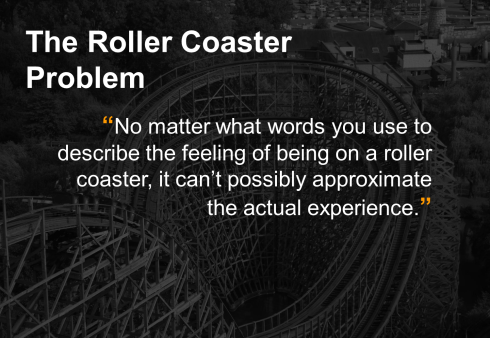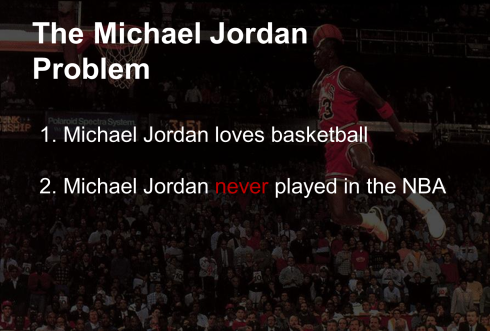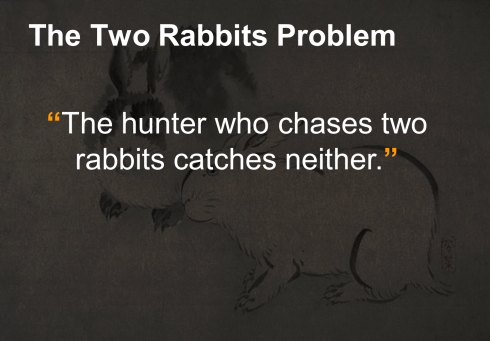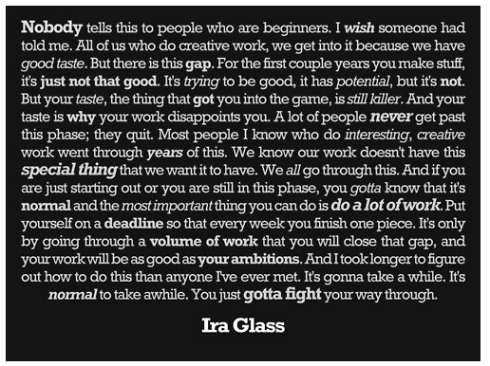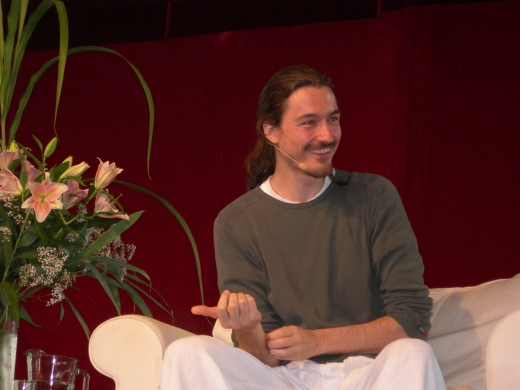
A modern mystic, Thomas Hubl, seems like a good dude, but his message just didn’t really resonate with me
Last night I went to a talk by Thomas Hubl in downtown Washington DC. He is an interesting guy and as a modern mystic, I certainly value his perspective on his experience of consciousness. I like attending events like this because they tend to open me up. Expose me to new ideas and new people. However, while I value that exposure, it isn’t always pleasant. And last night I was reminded why I had avoided the “integral community” for so many years.
Although we may share the same interests in learning and exploring spiritual, mystical, or consciousness-based experiences and ideas, we approach that interest in very different ways. I ended up feeling like what I was seeing was spiritual materialism at its finest. Now, I did like Thomas’s talk and I thought he had a lot of good ideas to share, but the most value I got out of the experience was in a flood of ideas of my own. When ideas come this fast and easily, I am prone to think that they are coming from deep inside me rather than my overly-analytical mind (of which I am skeptical). Even though I have several other draft blog posts in the cooker, I feel compelled to share this one immediately. I decided that the easiest way to share this would be to just quote what I wrote in my journal during Thomas’s talk and go from there. I am calling it, “In Defense of Ego.”
— Feb. 17, 2014—
I don’t understand this! He is talking as if the mind/ego was something bad. “We need to bring this consciousness to light in the modern world,” he says. We “need to!?” Huh? I mean, of course we “need” to, but that is just a function of our own drive to create and there is no way for me to tell if YOUR drive to create is coming from ego or from spirit. How or why would I even try to judge it? Of course, I am doing the exact same thing to Thomas right now, judging his words, so I’ll let them be. Clearly people are getting something out of them. For me though this isn’t about the exteriors being “bad” and the interiors being “good.” In fact, language itself is just an exterior. It is an exterior, mind-created, ego-driven tool that we use to communicate and self-reflect. We needed to create language as a scaffold to develop the interior, so how can we make a value judgement on it? We need the exterior to build the interior…but where did language come from? The interior!!! So, they are co-emergent. They are interdependent. It is much like the particle/wave theory of electrons. They are BOTH at the same time, it is only our perspective that seems to have the conflict with reconciling these two things. This is why having a non-dual awareness is so important. That is why we NEED the ego. The ego isn’t bad. The ego is just an exterior. Haha! Badness is using the qualities of a wave to judge what is acting like, in that moment, as a particle. OR using the values of the interior to judge the exterior (or using the exterior to judge the interior). Of course it causes a contraction/tension!
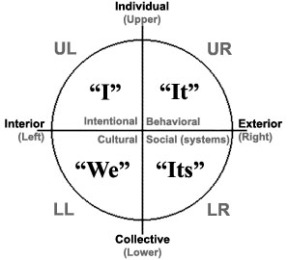
Wilber’s AQAL model for anyone not immediately familiar with how I am using the words, “interior” and “exterior”
Ego/mind/etc., or whatever word one wants to use to describe something “bad” or “negative,” when it is used in that way…doesn’t actually point to anything. That is, the word exists as a signifier…a sign post….but there is no signified. The sign points in a direction, but if you were to go there, you would find that nothing exists. In this way, ego has no content. It does not exist! It is so simple. We have a word for it, like we have the word “unicorn,” but that doesn’t mean that they signify something that exists in the real world. “Ego,” then doesn’t really exist in the way people use it to mean something negative or bad. In fact, what they are experiencing is the misattunement of TWO things that DO exist. How then do we bring those different rhythms into alignment? Well, I think through radical acceptance. Awareness is great. Awareness. Awareness. Awareness. Now try to accept. See if you can accept it as well. Create a new exterior. Create a new object. That that which was subject to you and make it object. Make it an exterior (that is, make it part of “mind/ego”). As an exterior, it may help you OR….maybe it is already an object…and you’ve divorced yourself from that object. These are the things that you need to bring into radical acceptance.
So, more simply…the “pain” or “resistance” or “contraction” or “tension” that we feel is NOT a result of a single entity (like the “ego”), but of a dynamic PROCESS between two entities (more akin to “friction”). Those two entities are exteriors and interiors. Existences and essences. Gross forms and subtle forms. The cure for these frictions depend on which way the energy is trying to flow. If energy is trying to create an exterior from an interior, then you need radical awareness, because you are trying to create something in the gross realm that previously existed in the subtle realm. However, it is equally likely that you are experiencing friction because something from the Gross realm is trying to enter the subtle realm (the equally important, but less acknowledged move from mind-body to spirit). In this case, as was my experience, the cure seems to be radical acceptance. That is, accepting everything even the things that you don’t accept. Or for radical awareness….radical awareness is being aware of what you are not aware of. This is why religions often talk about the masculine and feminine…big mind and big heart. Not just because these two THINGS exist, but because they represent two MOVEMENTS. Movement in one direction or another between exteriors and interiors! Masculine and feminine are horizontal types that describe movement between horizontal dimensions (exteriors and interiors). It is actually quite simple when looked at this way. So, to say that “ego” or “mind” is bad….as it feels like most people in this room are doing…just doesn’t make sense to me.
So, again, the one thing that we don;t really think about is that it is not the exteriors or the interiors themselves, but the MOVEMENT from one to the other. If there is friction in this movement then we experience suffering. This suffering can be cured with either radical acceptance or radical awareness depending on which direction the energy is trying to flow. Ok, so now we are cooking baby! 🙂 What is this movement? HOW the hell can you move from one to another? Well, we do that in the ground of being. That is…the movement can take place because we can stand outside of either two positions and “outside” those two positions is simply the background of all reality (both subtle and gross). Now, this ground of being is actually very boring, so I won’t talk about it because talking about it is a bit silly, but it is important to mention it because it is the third element….the causal realm. So, mystics claim that individual consciousness can directly experience this casual realm and I think that is fantastic. Good for them. Good for you if you can. Nothing wrong with it at all. Sounds like a magical place to live. But, for me, by definition, this causal experience doesn’t really mean much. That is because any experience is still just that….experience (even if that experience is non-experience…if that makes sense). So, then it is not something to strive for…it is something that people get access to or they do not. There is nothing great or grand about it. It is. Just like form and ego. They are. All of this stuff….is just hanging out. Now, don’t get me wrong the creation of something out of nothing is extraordinary….what could be more amazing!? But from my perspective, there is also nothing more mundane (again….it’s like a particle and a wave….causal is BOTH majestic AND mundane).

A particle AND a wave
So, when we talk about the gross (exterior), subtle (interior), and causal (ground that allows us to move from one to the other), we are just talking about the interplay between these two crazy characters. It is like some sort of stage play. Two characters battling it out. The two actors and the stage on which they stand…those three things make up what we call reality. This is why horizontal development is, in many ways, much more important than vertical development. Because the movement from left (interior) to right (exterior) is the ENGINE of development. These frictions, moving and moving and moving, can spark movements upward as appropriate to the challenges that you face. In fact, it is actually more like overcompensation. As that friction creates sparks, your subtle and gross mental fabric evolves. Just like how the fibers of your muscles strengthen through exercise. After lifting 100 pounds your muscles get bigger so that next time you can lift 115 pounds (since you clearly could ALREADY lift 100). So, the engine of vertical development is in fact horizontal movement.
Growth is about awareness and acceptance because “the bad” parts are simply friction that restrict movement. Resistance is only ever about the friction of movement which does NOT get better if we continue to value “spirit” over “ego.” In fact, it makes the problem worse. It creates a spiritual materialism in which a large portion of reality is denied and judged. Of course, this friction is exactly what we need. How else could it exist? Is = ought. So, from a non-dual perspective, there is nothing wrong. There is no point to changing anything. “So you’re miserable. Great! That is what you should be. You will be miserable until you are not.” I’m writing. You’re reading. So what? We are fine. Given that we are….and everything we do is okay, then let us continue talking and reading. If everything is OK, then it is also OK that we think things need to change.
—
So, there you go. That was the out-pouring of thought that I had. It was helpful for me in thinking it, I can only hope that it is helpful for you in reading it.
Tags: Consciousness, Ego, Integral

